Macroeconomic Policies and Great Recession in the US: Analysis
VerifiedAdded on 2022/09/12
|5
|1106
|31
Essay
AI Summary
This essay analyzes the macroeconomic policies employed by the United States to combat the Great Recession of 2008. It begins by defining recession and its impacts on economic indicators such as output, unemployment, income, and inflation. The essay then delves into the demand-side policies adopted by the US, specifically focusing on fiscal and monetary measures. The discussion of fiscal policies includes an analysis of tax cuts implemented under the Economic Stimulus Act of 2008 and the subsequent American Recovery and Reinvestment Act of 2009, highlighting their effectiveness. The essay also examines the monetary policies, including interest rate reductions and the introduction of quantitative easing by the Federal Reserve. The essay concludes by summarizing the impact of these policies, emphasizing that the fiscal policy proved more effective than the monetary policy in pulling the economy out of recession. The essay also references several academic sources to support its claims.
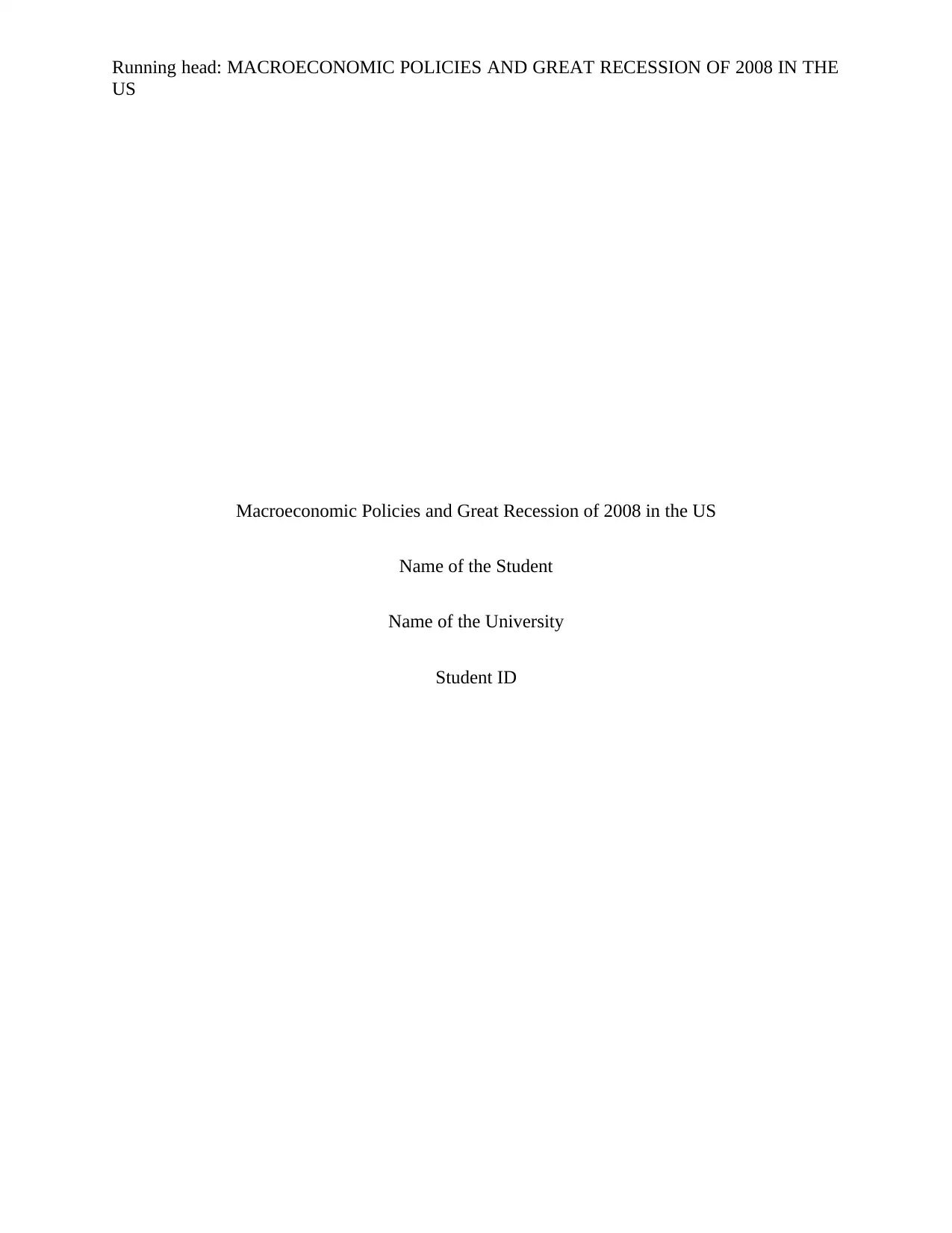
Running head: MACROECONOMIC POLICIES AND GREAT RECESSION OF 2008 IN THE
US
Macroeconomic Policies and Great Recession of 2008 in the US
Name of the Student
Name of the University
Student ID
US
Macroeconomic Policies and Great Recession of 2008 in the US
Name of the Student
Name of the University
Student ID
Paraphrase This Document
Need a fresh take? Get an instant paraphrase of this document with our AI Paraphraser
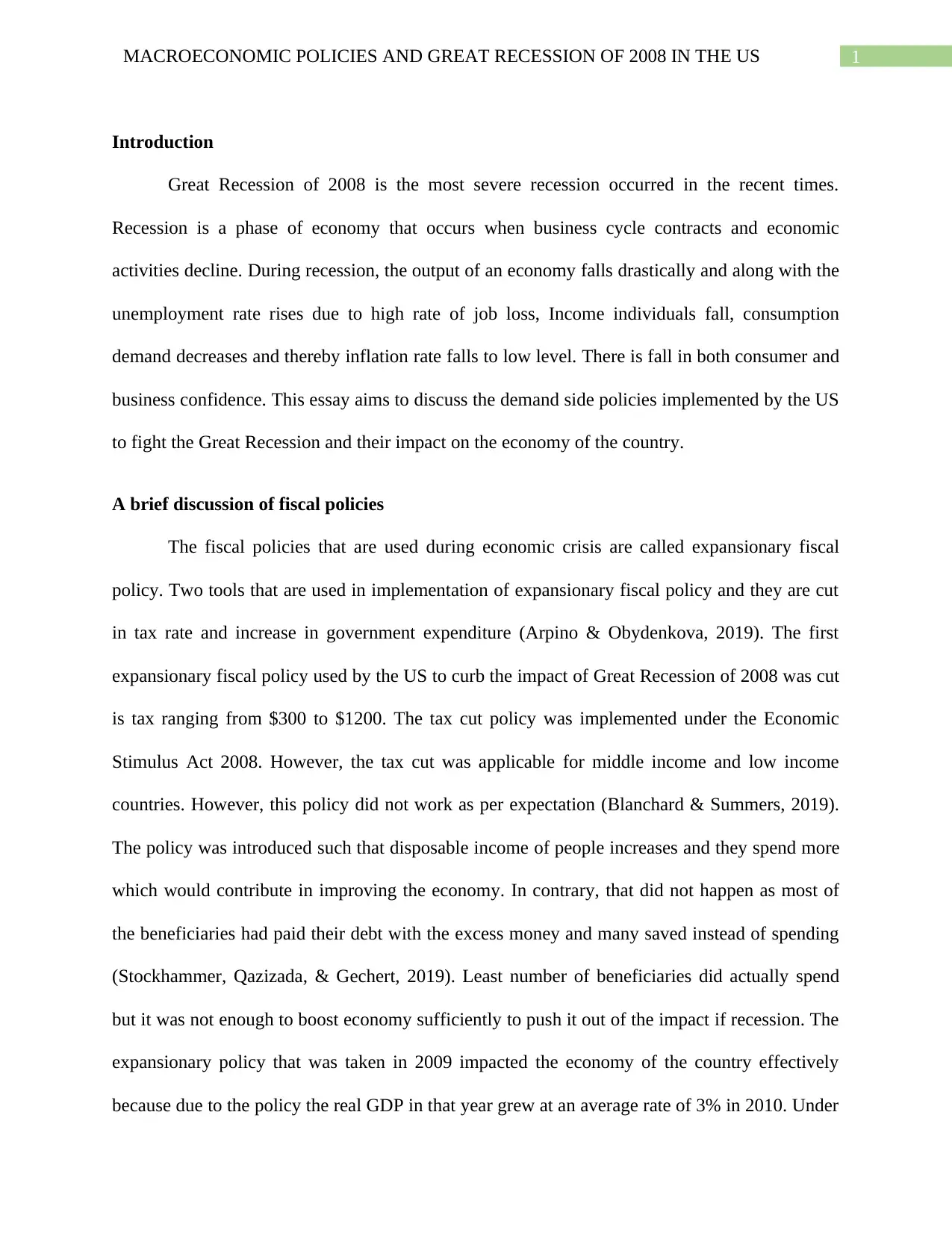
1MACROECONOMIC POLICIES AND GREAT RECESSION OF 2008 IN THE US
Introduction
Great Recession of 2008 is the most severe recession occurred in the recent times.
Recession is a phase of economy that occurs when business cycle contracts and economic
activities decline. During recession, the output of an economy falls drastically and along with the
unemployment rate rises due to high rate of job loss, Income individuals fall, consumption
demand decreases and thereby inflation rate falls to low level. There is fall in both consumer and
business confidence. This essay aims to discuss the demand side policies implemented by the US
to fight the Great Recession and their impact on the economy of the country.
A brief discussion of fiscal policies
The fiscal policies that are used during economic crisis are called expansionary fiscal
policy. Two tools that are used in implementation of expansionary fiscal policy and they are cut
in tax rate and increase in government expenditure (Arpino & Obydenkova, 2019). The first
expansionary fiscal policy used by the US to curb the impact of Great Recession of 2008 was cut
is tax ranging from $300 to $1200. The tax cut policy was implemented under the Economic
Stimulus Act 2008. However, the tax cut was applicable for middle income and low income
countries. However, this policy did not work as per expectation (Blanchard & Summers, 2019).
The policy was introduced such that disposable income of people increases and they spend more
which would contribute in improving the economy. In contrary, that did not happen as most of
the beneficiaries had paid their debt with the excess money and many saved instead of spending
(Stockhammer, Qazizada, & Gechert, 2019). Least number of beneficiaries did actually spend
but it was not enough to boost economy sufficiently to push it out of the impact if recession. The
expansionary policy that was taken in 2009 impacted the economy of the country effectively
because due to the policy the real GDP in that year grew at an average rate of 3% in 2010. Under
Introduction
Great Recession of 2008 is the most severe recession occurred in the recent times.
Recession is a phase of economy that occurs when business cycle contracts and economic
activities decline. During recession, the output of an economy falls drastically and along with the
unemployment rate rises due to high rate of job loss, Income individuals fall, consumption
demand decreases and thereby inflation rate falls to low level. There is fall in both consumer and
business confidence. This essay aims to discuss the demand side policies implemented by the US
to fight the Great Recession and their impact on the economy of the country.
A brief discussion of fiscal policies
The fiscal policies that are used during economic crisis are called expansionary fiscal
policy. Two tools that are used in implementation of expansionary fiscal policy and they are cut
in tax rate and increase in government expenditure (Arpino & Obydenkova, 2019). The first
expansionary fiscal policy used by the US to curb the impact of Great Recession of 2008 was cut
is tax ranging from $300 to $1200. The tax cut policy was implemented under the Economic
Stimulus Act 2008. However, the tax cut was applicable for middle income and low income
countries. However, this policy did not work as per expectation (Blanchard & Summers, 2019).
The policy was introduced such that disposable income of people increases and they spend more
which would contribute in improving the economy. In contrary, that did not happen as most of
the beneficiaries had paid their debt with the excess money and many saved instead of spending
(Stockhammer, Qazizada, & Gechert, 2019). Least number of beneficiaries did actually spend
but it was not enough to boost economy sufficiently to push it out of the impact if recession. The
expansionary policy that was taken in 2009 impacted the economy of the country effectively
because due to the policy the real GDP in that year grew at an average rate of 3% in 2010. Under
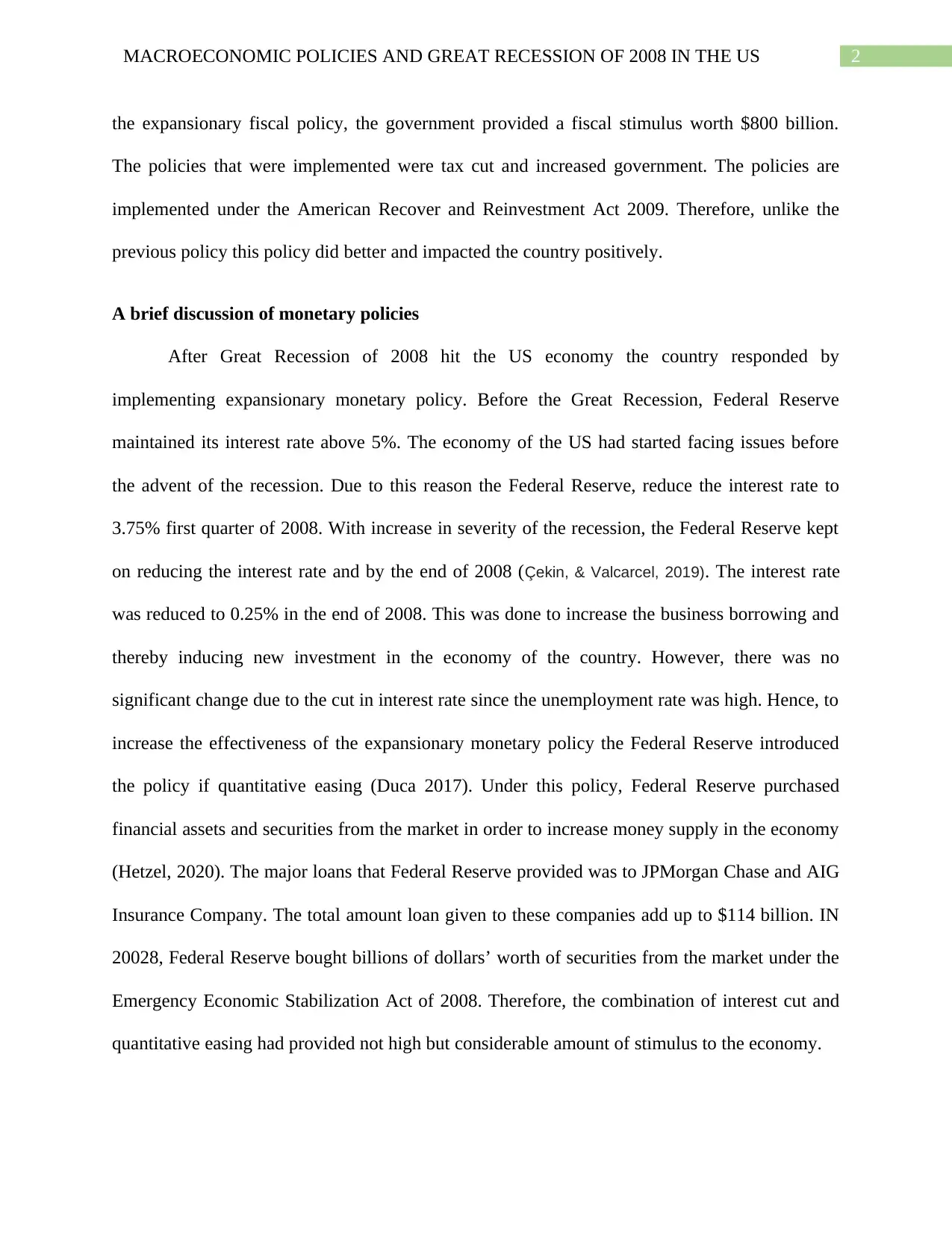
2MACROECONOMIC POLICIES AND GREAT RECESSION OF 2008 IN THE US
the expansionary fiscal policy, the government provided a fiscal stimulus worth $800 billion.
The policies that were implemented were tax cut and increased government. The policies are
implemented under the American Recover and Reinvestment Act 2009. Therefore, unlike the
previous policy this policy did better and impacted the country positively.
A brief discussion of monetary policies
After Great Recession of 2008 hit the US economy the country responded by
implementing expansionary monetary policy. Before the Great Recession, Federal Reserve
maintained its interest rate above 5%. The economy of the US had started facing issues before
the advent of the recession. Due to this reason the Federal Reserve, reduce the interest rate to
3.75% first quarter of 2008. With increase in severity of the recession, the Federal Reserve kept
on reducing the interest rate and by the end of 2008 (Çekin, & Valcarcel, 2019). The interest rate
was reduced to 0.25% in the end of 2008. This was done to increase the business borrowing and
thereby inducing new investment in the economy of the country. However, there was no
significant change due to the cut in interest rate since the unemployment rate was high. Hence, to
increase the effectiveness of the expansionary monetary policy the Federal Reserve introduced
the policy if quantitative easing (Duca 2017). Under this policy, Federal Reserve purchased
financial assets and securities from the market in order to increase money supply in the economy
(Hetzel, 2020). The major loans that Federal Reserve provided was to JPMorgan Chase and AIG
Insurance Company. The total amount loan given to these companies add up to $114 billion. IN
20028, Federal Reserve bought billions of dollars’ worth of securities from the market under the
Emergency Economic Stabilization Act of 2008. Therefore, the combination of interest cut and
quantitative easing had provided not high but considerable amount of stimulus to the economy.
the expansionary fiscal policy, the government provided a fiscal stimulus worth $800 billion.
The policies that were implemented were tax cut and increased government. The policies are
implemented under the American Recover and Reinvestment Act 2009. Therefore, unlike the
previous policy this policy did better and impacted the country positively.
A brief discussion of monetary policies
After Great Recession of 2008 hit the US economy the country responded by
implementing expansionary monetary policy. Before the Great Recession, Federal Reserve
maintained its interest rate above 5%. The economy of the US had started facing issues before
the advent of the recession. Due to this reason the Federal Reserve, reduce the interest rate to
3.75% first quarter of 2008. With increase in severity of the recession, the Federal Reserve kept
on reducing the interest rate and by the end of 2008 (Çekin, & Valcarcel, 2019). The interest rate
was reduced to 0.25% in the end of 2008. This was done to increase the business borrowing and
thereby inducing new investment in the economy of the country. However, there was no
significant change due to the cut in interest rate since the unemployment rate was high. Hence, to
increase the effectiveness of the expansionary monetary policy the Federal Reserve introduced
the policy if quantitative easing (Duca 2017). Under this policy, Federal Reserve purchased
financial assets and securities from the market in order to increase money supply in the economy
(Hetzel, 2020). The major loans that Federal Reserve provided was to JPMorgan Chase and AIG
Insurance Company. The total amount loan given to these companies add up to $114 billion. IN
20028, Federal Reserve bought billions of dollars’ worth of securities from the market under the
Emergency Economic Stabilization Act of 2008. Therefore, the combination of interest cut and
quantitative easing had provided not high but considerable amount of stimulus to the economy.
⊘ This is a preview!⊘
Do you want full access?
Subscribe today to unlock all pages.

Trusted by 1+ million students worldwide
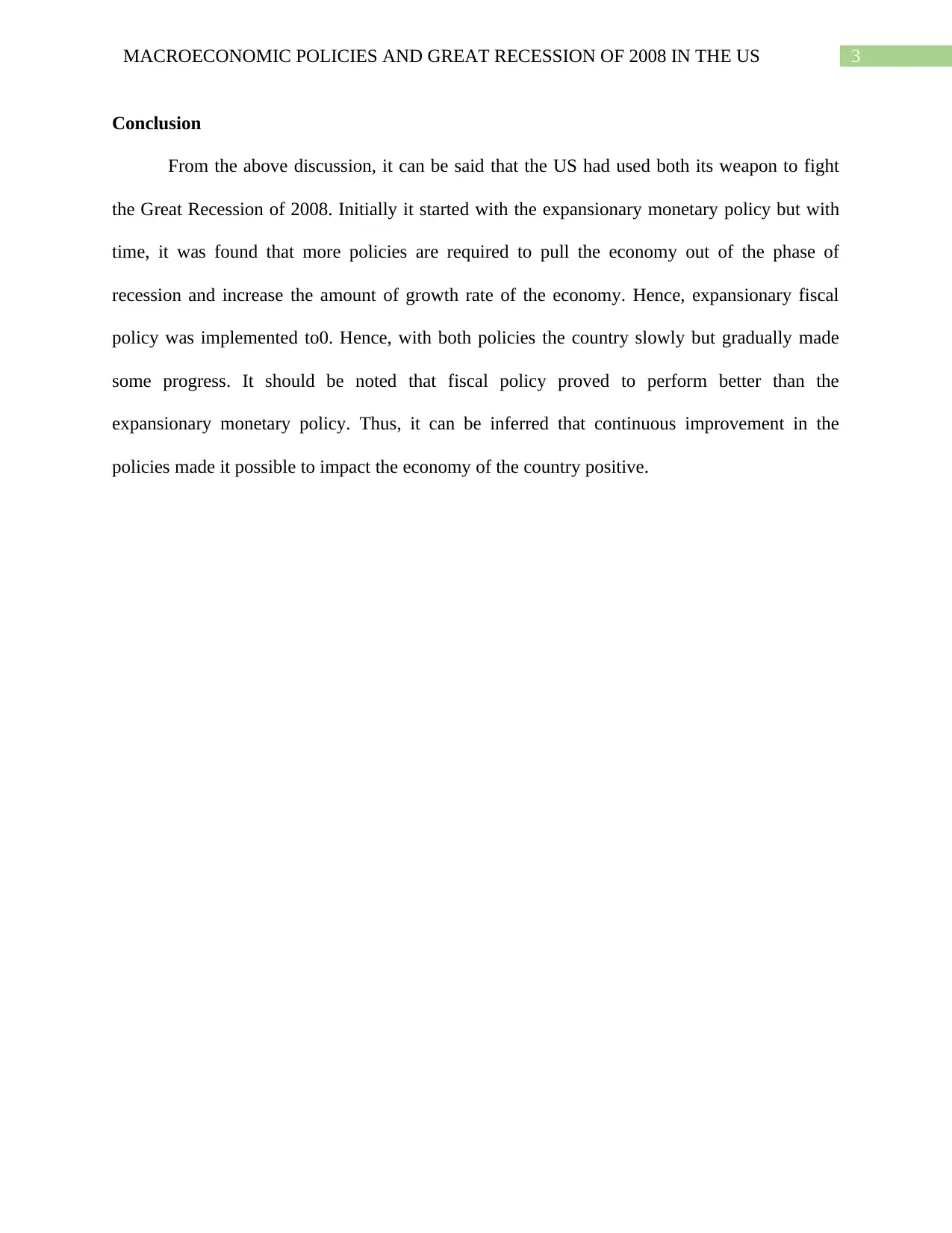
3MACROECONOMIC POLICIES AND GREAT RECESSION OF 2008 IN THE US
Conclusion
From the above discussion, it can be said that the US had used both its weapon to fight
the Great Recession of 2008. Initially it started with the expansionary monetary policy but with
time, it was found that more policies are required to pull the economy out of the phase of
recession and increase the amount of growth rate of the economy. Hence, expansionary fiscal
policy was implemented to0. Hence, with both policies the country slowly but gradually made
some progress. It should be noted that fiscal policy proved to perform better than the
expansionary monetary policy. Thus, it can be inferred that continuous improvement in the
policies made it possible to impact the economy of the country positive.
Conclusion
From the above discussion, it can be said that the US had used both its weapon to fight
the Great Recession of 2008. Initially it started with the expansionary monetary policy but with
time, it was found that more policies are required to pull the economy out of the phase of
recession and increase the amount of growth rate of the economy. Hence, expansionary fiscal
policy was implemented to0. Hence, with both policies the country slowly but gradually made
some progress. It should be noted that fiscal policy proved to perform better than the
expansionary monetary policy. Thus, it can be inferred that continuous improvement in the
policies made it possible to impact the economy of the country positive.
Paraphrase This Document
Need a fresh take? Get an instant paraphrase of this document with our AI Paraphraser
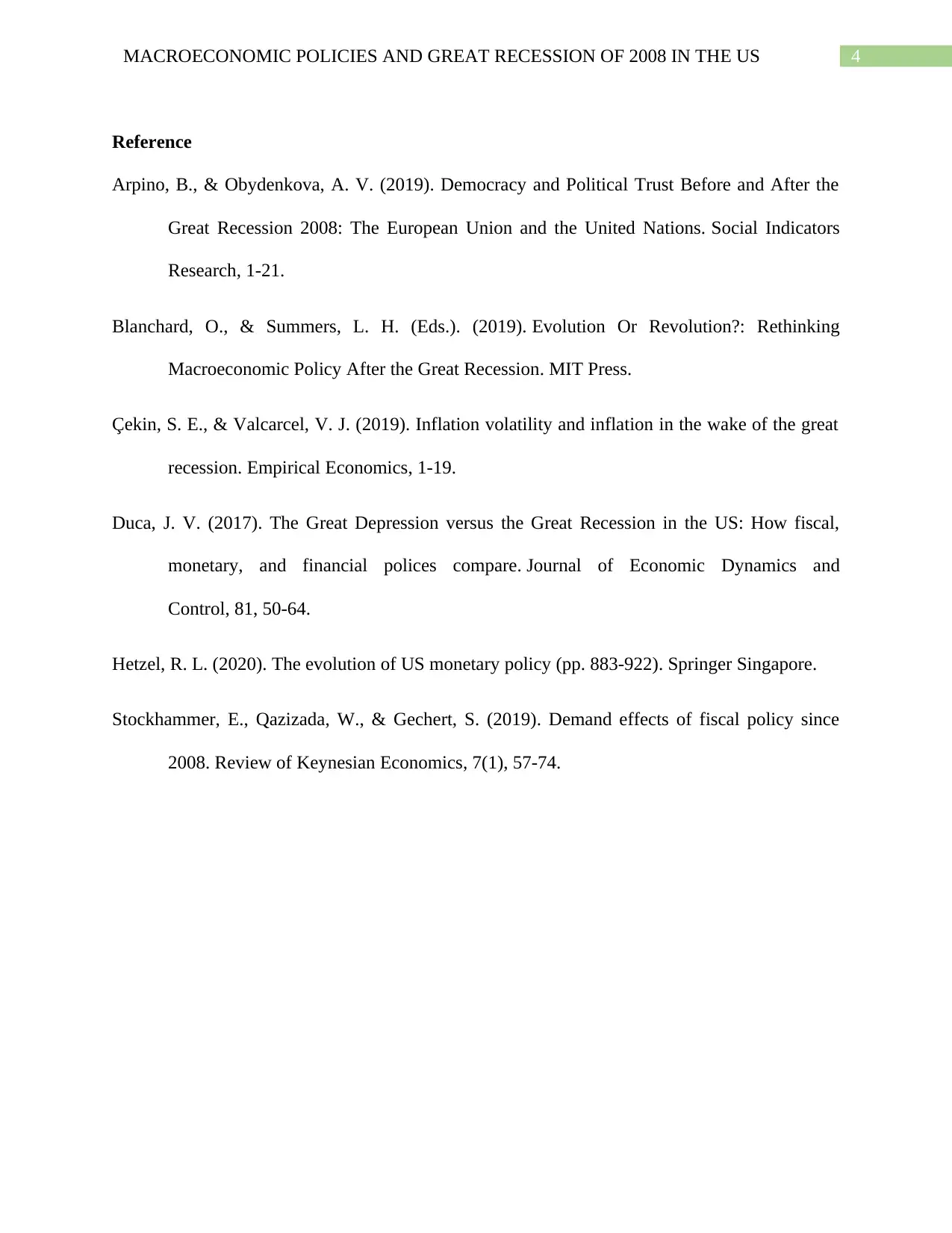
4MACROECONOMIC POLICIES AND GREAT RECESSION OF 2008 IN THE US
Reference
Arpino, B., & Obydenkova, A. V. (2019). Democracy and Political Trust Before and After the
Great Recession 2008: The European Union and the United Nations. Social Indicators
Research, 1-21.
Blanchard, O., & Summers, L. H. (Eds.). (2019). Evolution Or Revolution?: Rethinking
Macroeconomic Policy After the Great Recession. MIT Press.
Çekin, S. E., & Valcarcel, V. J. (2019). Inflation volatility and inflation in the wake of the great
recession. Empirical Economics, 1-19.
Duca, J. V. (2017). The Great Depression versus the Great Recession in the US: How fiscal,
monetary, and financial polices compare. Journal of Economic Dynamics and
Control, 81, 50-64.
Hetzel, R. L. (2020). The evolution of US monetary policy (pp. 883-922). Springer Singapore.
Stockhammer, E., Qazizada, W., & Gechert, S. (2019). Demand effects of fiscal policy since
2008. Review of Keynesian Economics, 7(1), 57-74.
Reference
Arpino, B., & Obydenkova, A. V. (2019). Democracy and Political Trust Before and After the
Great Recession 2008: The European Union and the United Nations. Social Indicators
Research, 1-21.
Blanchard, O., & Summers, L. H. (Eds.). (2019). Evolution Or Revolution?: Rethinking
Macroeconomic Policy After the Great Recession. MIT Press.
Çekin, S. E., & Valcarcel, V. J. (2019). Inflation volatility and inflation in the wake of the great
recession. Empirical Economics, 1-19.
Duca, J. V. (2017). The Great Depression versus the Great Recession in the US: How fiscal,
monetary, and financial polices compare. Journal of Economic Dynamics and
Control, 81, 50-64.
Hetzel, R. L. (2020). The evolution of US monetary policy (pp. 883-922). Springer Singapore.
Stockhammer, E., Qazizada, W., & Gechert, S. (2019). Demand effects of fiscal policy since
2008. Review of Keynesian Economics, 7(1), 57-74.
1 out of 5
Related Documents
Your All-in-One AI-Powered Toolkit for Academic Success.
+13062052269
info@desklib.com
Available 24*7 on WhatsApp / Email
![[object Object]](/_next/static/media/star-bottom.7253800d.svg)
Unlock your academic potential
Copyright © 2020–2025 A2Z Services. All Rights Reserved. Developed and managed by ZUCOL.





